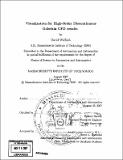| dc.contributor.advisor | Robert Haimes. | en_US |
| dc.contributor.author | Walfisch, David | en_US |
| dc.contributor.other | Massachusetts Institute of Technology. Dept. of Aeronautics and Astronautics. | en_US |
| dc.date.accessioned | 2008-09-03T14:51:54Z | |
| dc.date.available | 2008-09-03T14:51:54Z | |
| dc.date.copyright | 2007 | en_US |
| dc.date.issued | 2007 | en_US |
| dc.identifier.uri | http://hdl.handle.net/1721.1/42196 | |
| dc.description | Thesis (S.M.)--Massachusetts Institute of Technology, Dept. of Aeronautics and Astronautics, 2007. | en_US |
| dc.description | Includes bibliographical references (p. 69-71). | en_US |
| dc.description.abstract | This thesis demonstrates a technique that reduces the perceived error introduced in the visualization of higher-order DG solutions with traditional tools. Most visualization techniques work by using the solution at the mesh vertices and linearly interpolating to color the interior of the element. For higher-order solutions (where the visualization mesh is the same as the solution mesh) this method renders the high-order solution linear. By inserting new nodes at element quadrature points where the difference between the actual solution and the linear rendering is above a user-defined tolerance, additional elements are created and used for the visualization process. In order to keep the counts low for this new mesh, after each insertion a local rearrangement is performed to readapt the parent element so that the total visualization error is reduced. The method introduced here has many advantages over isotropic adaptation used by some higher-order visualization techniques. Isotropic adaptation adapts all the elements regardless of error, thus creating a higher total element count and therefore requiring more memory and rendering time. In some cases isotropic elements are not ideal in representing the solution (ie: boundary layers, shocks, wakes, etc.). Lastly, by providing an option to define the maximum visualization error allows the user to specify how close the visualized solution is to the actual calculated one (at the expense of a denser visualization mesh). Second, this work introduces a new method to apply an accuracy maintaining post-processor on DG vector fields to improve on the standard streamlining algorithms. Time integration methods do not work accurately and may even fail on discontinuos fields. The post-processor smoothens the field and eliminates the discontinuity between elements thus resulting in more accurate streamlines. To keep down the computational cost of the method, the post-processing is done in a one dimensional manner along the streamline. | en_US |
| dc.description.statementofresponsibility | by David Walfisch. | en_US |
| dc.format.extent | 71 p. | en_US |
| dc.language.iso | eng | en_US |
| dc.publisher | Massachusetts Institute of Technology | en_US |
| dc.rights | M.I.T. theses are protected by
copyright. They may be viewed from this source for any purpose, but
reproduction or distribution in any format is prohibited without written
permission. See provided URL for inquiries about permission. | en_US |
| dc.rights.uri | http://dspace.mit.edu/handle/1721.1/7582 | en_US |
| dc.subject | Aeronautics and Astronautics. | en_US |
| dc.title | Visualization for high-order discontinuous Galerkin CFD results | en_US |
| dc.title.alternative | Visualization for high-order DG Computational Fluid Dynamics results | en_US |
| dc.type | Thesis | en_US |
| dc.description.degree | S.M. | en_US |
| dc.contributor.department | Massachusetts Institute of Technology. Department of Aeronautics and Astronautics | |
| dc.identifier.oclc | 230816160 | en_US |
